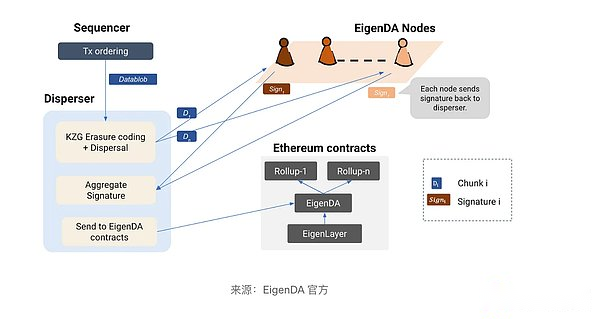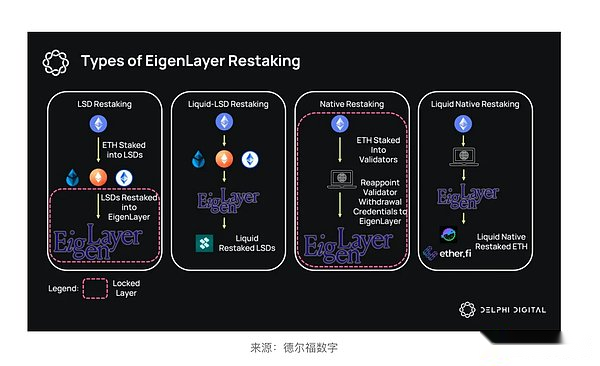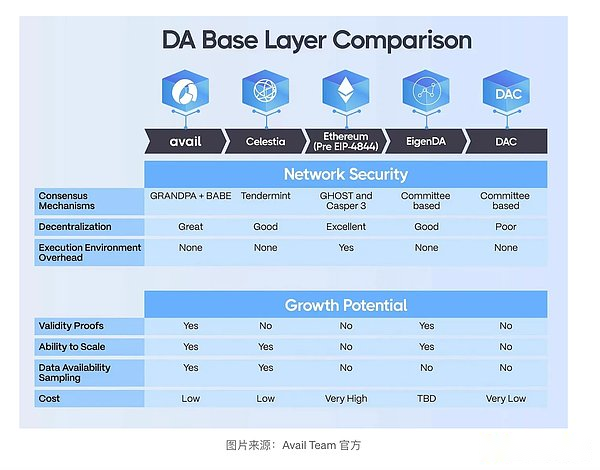
Author: AC-Core, YBB Capital Translation: Shan Oba, Bitchain Vision
Foreword
According to the definition of the Ethereum Foundation, the Layer2 of Ethereum is equal to rollup.Vitalik’s recent new point of view believes that if other EVM chains use non -Ethereum as a data availability (DA) layer, it belongs to Ether Validium (move the availability layer of the blockchain to the chain).Despite the DA problem, the exact definition of Layer2 still has certain controversy, but the upgrade route of Taifang is still centered on Rollup. Data usability plays a key role in saving or uploading Rollup transaction data in Ethereum upgrade.ZK Rollup access related data through data availability layers, even if the dependencies are different, it will affect their own security to a certain extent.Faced with COSMOS shared security innovation, data availability penetration of Celestia, and market -driven markets, can Eigenlayer re -recover market dominance by relying on its native Ethereum borrowing function?
Eigenlayer
>
Simple understanding, Eigenlayer is a RE-Stake protocol based on Ethereum, providing Ethereum-level security for the entire future-based encrypted economy.It allows users to redefine through Eigenlayer smart contracts to redefine the native ETH, LSDETH and LP Token and get verification rewards to allow third -party projects to receive more rewards while enjoying ETH’s main network security, thereby achieving a win -win situation.
The reason why Ethereum can attract a large amount of transaction volume and liquidity is because it is currently recognized by most people as the safest first -level blockchain except Bitcoin, and EIGENLAYER directly connects EtherThe safety and liquidity of currency (AVS) are essentially entrusted to Ethereum for the security verification of its token model.The essence is to directly entrust the security verification of its token to the Ethereum node (it can be simply understood as a node operator). This process is called “RE-Stake”.In this article, we only quote the first AVS project developed by the Eigenlayer team: EIGENDA.
EIGENDA: Summary data usability
>
According to the official interpretation and introduction (there is no actual related data support for the time being), EIGENDA uses the decentralized data availability (DA) service built on Ether with Eigenlayer Restake, and it will be the first active verification service (AVS) this levy layer.EssenceRESTAKERS can entrust the pledge to node operators executing EIGENDA, perform verification tasks, and charge service fees in return. Rollups can publish data to EIGENDA to reduce transaction costs, achieve higher transaction throughput, and increase the entire entire transaction throughput.EIGENLAYER ecosystem security.The security and transaction throughput of this development process will expand with the amount of pledge, related ecological agreements, and the overall growth of operators.
EIGENDA aims to provide innovative DA solutions for Rollups, allowing Etinsic pledges and verificationers to connect to each other, while increasing throughput and reducing costs. EIGENLAYER sharing safety systems use multi -node to ensure decentralization.According to EIGENDA, its integrated Layer2 solution includes CELO, transition from L1 to Ethernet L2; Mantle and its BitDao ecosystems other than supporting products; FLUENT provides ZKWASM execution layer; offshore, provides Move execution layers; and optimistic ones; optimistic onesOP stack.Currently used on the EIGENDA test network).
EIGENDA is a safe, high throughput, decentralized data availability (DA) service, based on Eigenlayer RESTAKE, based on Ether.The following are some of the main functions and advantages of EIGENDA designed to achieve:
feature:
-
Sharing Security: EIGENDA uses Eigenlayer’s shared security model to enable Retakers to contribute to ETH to participate in the verification process to improve the overall security of the network;
-
Data usability: The main goal of EIGENDA is to ensure the availability of data on the 2nd network.It uses a verification device to verify and ensure the effectiveness of data on the Rollup network, prevent adverse behaviors and ensure the normal operation of the network;
-
Decentralized sorting: EIGENDA uses Eigenlayer’s decentralized sorting mechanism to ensure that transactions in the ROLLUP network are implemented in the correct order, so as to maintain the correctness and consistency of the entire system;
-
Flexibility: The design of EIGENDA allows L2 developers to adjust various parameters as required, including weighing between security and active, pledged token model, and correcting coding ratio to meet different scenarios and needs.
Advantages:
-
Economic benefits: EIGENDA realizes ETH sharing security through Eigenlayer, thereby reducing potential pledge costs.Through decentralized data verification work and reduce the operating costs of each operator, provide more cost -effective verification services;
-
High throughput: EIGENDA is designed to expand horizontally, as more operators join the network to increase their throughput.In private testing, EIGENDA showed a throughput of up to 10 MBPS and formulated a roadmap that expanded to 1 GBPS, providing possibilities for supporting high bandwidth applications such as multiplayer games and video streams;
-
Safety mechanism: EIGENDA uses a multi -layered security mechanism, including EIGENLAYER’s sharing security, custody certification mechanism and dual arbitration to ensure network security, decentralization and anti -review;
-
Customization: EIGENDA provides flexible design that allows L2 developers to find the balance between security and performance by adjusting various parameters according to their specific needs and use cases.
Re -pledge mode
>
-
Native ETH heavy pledge:
For independent ETH pledges, they can point the pledged ETH to Eigenlayer smart contracts through withdrawal vouchers to reintegrate and obtain additional income.If the independent pledged person has improper behavior, EIGENLAYER can directly lose its withdrawal voucher;
-
LST supplement:
LST (liquid stake token) represents liquid pledged tokens.Even if there are no 32 ETHs, ordinary investors can “carpool” through liquid pledges such as LIDO, Rocket Pool, deposit their ETH into the pledged pool, and get the promise of LST, which represents its ETH and income obtaining rights.Users who have pledged ETH who have pledged ETH in Lido and Rocket Pool can transfer the LST LST to the EIGENLAYER smart contract to achieve re -pledges to obtain additional returns;
-
LP token re -pledge:
LP tokens are divided into ETH LP and LST LP accumulation.
-
ETH LP Re -pledge: Users can re -pledge a pair of DEFI protocol LP tokens containing ETH containing ETH.
-
LST LP Re -pledge: Users can reintegrate a pair of DEFI protocols containing LSDETH protocol LP token to Eigenlayer.For example, the STETH-ETH LP Token of the Curve protocol can be re-pledged to Eigenlayer.
Celestia in cosmos
>
At present, no blockchain can really solve the problem of triangular measurement problems that are impossible for decentralized, secure and scalable blockchain. COSMOS believes that only multi -chain design architecture can overcome the balance between them to a certain extent.Before discussing Celestia, let’s briefly review COSMOS. Among them, the blockchain is interactive through the IBC (blockchain communication) protocol.Let’s discuss the security between the cosmos chain in detail below:
IBC protocol security: IBC is a protocol that ensures communication between the chain in the COSMOS network.It ensures the confidentiality and integrity of the message through encryption and signature mechanisms.The IBC protocol includes a series of certification steps to ensure the credibility of inter -chain communication.Through IBC, the COSMOS chain can safely transmit messages and assets to prevent fraud and tampering;
Consensus mechanism is safe: each blockchain in the COSMOS ecosystem may use different consensus mechanisms, the most common of which is Tendermint.Tendermint consensus algorithm ensures consistency between nodes through BFT fault tolerance (BFT).This means that the system can still run normally without the existence of a certain number of malicious nodes.The security of the consensus mechanism is very important for the stability and security of the entire network;
HUB security: There is a centralized blockchain HUB in the COSMOS network, which acts as a bridge between different chains.HUB’s security plays a key role in the stability of the entire ecosystem.If HUB is not safe, it may cause problems in the entire network.Therefore, ensuring the security of HUB is an important task in the COSMOS ecosystem, which involves strict control of its consensus mechanism and node management;
Asset security: As the assets can be transferred between the COSMOS chain, it is important to ensure its safety.By using cryptography, the COSMOS chain can prevent malicious activities such as double flower attacks.At the same time, the IBC agreement aims to make the asset transfers safely and reliable;
Smart contract and application layer security: COSMOS network allows the development of smart contracts and distributed applications.Ensuring the security of this level is achieved by ensuring the code quality, audit and vulnerability repair of smart contracts and applications running on the blockchain.
Celestia realizes scalability and flexibility through the modular design of consensus and execution, and provides customized ecosystems for various blockchain solutions.In contrast, COSMOS promotes blockchain collaboration in an ecosystem neutral, emphasizes the interconnection between independent blockchain, and uses Tendermint to integrate consensus and execute to provide a cohesive environment.The negative impact of losing its own flexibility.Celestia’s modularity method provides enhanced scalability, development flexibility and customized solutions to meet the needs of different applications. Some people call on Celestia+COSMOS to become the final form of future application chains.
Celestia’s ICS and EIGENLAYER EIGENDA
>
However, it is worth noting that ICS (chain security) is mentioned recently in Celestia’s proposal, not Eigenlayer. EIGENLAYER is a data availability layer based on Ethereum, as well as some comparison between ICS and EIGENLAYER, as well as their.The relationship between the intercourse can be understood in the following ways:
-
Sharing Security: Celestia’s proposal discusses the possibility of using ICS to use the verification device in the COSMOS ecosystem (such as the verification device in the COSMOS HUB) as the Rollup sorter of Celestia.This method will allow multiple ROLLUP networks to share the same set of verifications to achieve sharing security.This idea is a bit similar to the sharing of security in Eigenlayer, because both uses the vernacles of the underlying blockchain network to provide security.The difference is that ICS uses the COSMOS HUB verification device to provide verification services to the connected blockchain, and improves the security of the entire ecosystem through a shared security model. EIGENDA provides verification services through Eigenlayer on Ethereum.The data availability of the validator verification Rollup network;
-
Decentralization sequencer: The concept of decentralized sequencer mentioned by Celestia uses the ICS method.This is a bit similar to using Eigenlayer’s RESTAKE Primitive (Repledge mechanism) in Eigenlayer to build decentralized sorters.Both try to achieve a more decentralized sorting mechanism through the attributes of the underlying protocol;
-
Rollups combined: Celestia mentioned that cross -RollUp combined ability can be achieved by using the same sequencer (probably through ICS) in multiple ROLLUP networks.This is a bit similar to the goals mentioned in Eigenlayer. I hope that there are multiple AVS (active verification services) in the Eigenlayer ecosystem to cooperate with each other to achieve higher levels of combination and interoperability;
-
Economic: Aside from the technical level of Celestia and Eigenlayer. From the perspective of the market, users are more concerned about their own income, and Eigenlayer is slightly stronger than Celestia in the LST layered income stack.In the future, the expected value of the entire Eigenlayer ecosystem airdrop.
Comparison between DA layers
>
Data usability (DA) referred to as DA.At present, in EtherChannel’s upgrade route, the entire process is mainly based on rollup, and the role of DA in this process is to save or upload all trading data of the entire Rollup.The emergence of rollup is to solve the problem of scalability Layer1, but the actual access of Layer2 data through DA can affect the overall security and TPS level.Layer2 data will affect the overall security and TPS level. In order to allow Layer2 to inherit the security of Ethernet, Ethernet needs to achieve a large amount of Layer2 data upload by optimizing the entire protocol security mechanism.
In the consensus mechanism, there is a fundamental dilemma, that is, effectiveness and security. The former guarantees the rapid treatment of transactions, and the latter ensures the accuracy and security of the transaction.Choose to achieve the balance of meeting their actual needs.Ethereum, Celestia, Eigenlayer, and Avail solutions are designed to provide scalable data availability for Rollup. According to the data provided by Researcher@Likebeckett and Avail, my summary is as follows.
>
Celestia:
-
Decentralized sorter proposal: CELESTIA discusses a proposal proposed by the chief operating officer Nick White.Provide sharing security for the DA layer through ICS.Use the COSMOS HUB verification device to achieve the sharing security of the DA layer through ICS;
-
Atomic composability across rollup: Celestia improves combined ability by using ICS to achieve atomic transactions across multiple ROLLUP networks.The same sequencer enables multiple ROLLUP networks to work together to solve the dispersible mobility and reduce the combined availability;
-
Multi -Rollup interoperability: Using the same sequencer, Celestia promotes the interoperability between multiple ROLLUP networks to achieve better mobility and data availability.
Eigenlayer and EIGENDA:
-
Data availability services with shared security: Eigenlayer provides data availability services through EIGENDA. Unlike traditional blockchain, EIGENDA is a set of smart contracts built by Ethereum to use the concept of sharing security.EIGENDA can be used as part of the Celestia ecosystem, providing efficient, secure, scalable data availability;
-
Decentralized sorting: EIGENLAYER emphasizes its decentralized sorting mechanism. It is essentially adding ETH tokens and fines in the POS process of the Rollup sorter to provide higher security for the Layer 2 network.Through this mechanism, Eigenlayer has achieved an efficient sorting process;
-
Data usability service: EIGENDA focuses on providing data availability services to the second -layer network. Through EIGENLAYER’s shared security and decentralized sorting, it provides high -performance data transmission for applications on the chain.
it works.
-
Data usability design: Avail focuses on data availability design and introduces data availability sampling technology.This technology allows light nodes to verify the availability of data by downloading only one part of the block, rather than relying on the entire node to obtain data, thereby improving the scalability of the network;
-
Interaction between blockchain: Avail is designed to improve interaction between blockchain.Support the light node of data availability sampling, which can more flexibly increase the size of the block and increase the overall throughput;
-
EIP 4844 Adaptation: Avail actively participates in the implementation of Ethereum EIP 4844. EIP 4844 is a key component of the Polygon modular blockchain vision. The proposal aims to increase the size of the block and lay the foundation for the implementation of Danksharnding, so that Avail can adapt toUpgrade in the Ethereum ecosystem.
in conclusion
For ROLLUP, in the past 24 years, in addition to the definition of narrative brought by the upgrade of Cancun, the dispute between the DA problem also brings questions about the accurate positioning of Layer2.For the time being, the orthodox, security, and cost issues that Ether Ether data are actually faced. This CELESTIA VS EIGENDA dispute is not difficult to lead to a thinking. Under the Ether Killer and Ether Protector’s confrontation, whether it will lead to more market competition in the futureDeveloped towards the direction of the combined module, so that a new round of flowers appear in the way of Ethereum expansion.
Although the blockchain itself has many limitations, from the perspective of the financial market, a large part of the rising power of all markets comes from “assumption space”. This space always requires fresh stories to feed.In terms of innovation itself, in addition to maintaining its own correctness, the “branch road” is also a narrative direction outside the original framework.








